Neural Network-Based Prediction of Vehicle Fuel Consumption Based on Driving Cycle Data
Abstract
:1. Introduction
2. Driving Cycle Processing and Analysis
2.1. Recorded Data
2.2. Data Processing
3. Fuel Consumption Modeling
3.1. Linear Regression Models
3.2. Neural Network (NN)-Based Modeling
4. Comparative Results
5. Conclusions
Author Contributions
Funding
Institutional Review Board Statement
Informed Consent Statement
Data Availability Statement
Acknowledgments
Conflicts of Interest
References
- Yao, Y.; Zhao, X.; Liu, C.; Rong, J.; Zhang, Y.; Dong, Z.; Su, Y. Vehicle Fuel Consumption Prediction Method Based on Driving Behavior Data Collected from Smartphones. J. Adv. Transp. 2020, 2020, 1–11. [Google Scholar] [CrossRef]
- Kedia, R.K.; Naick, B.K. Review of vehicle route optimisation. In Proceedings of the 2017 2nd IEEE International Conference on Intelligent Transportation Engineering (ICITE), Singapore, 1–3 September 2017; pp. 57–61. [Google Scholar]
- Hu, L.; Zhong, Y.; Hao, W.; Moghimi, B.; Huang, J.; Zhang, X.; Du, R. Optimal Route Algorithm Considering Traffic Light and Energy Consumption. IEEE Access 2018, 6, 59695–59704. [Google Scholar] [CrossRef]
- Wickramanayake, S.; Bandara, H.M.N.D. Fuel consumption prediction of fleet vehicles using Machine Learning: A comparative study. In Proceedings of the 2016 Moratuwa Engineering Research Conference (MERCon), Moratuwa, Sri Lanka, 5–6 April 2016; pp. 90–95. [Google Scholar] [CrossRef]
- Ben-Chaim, M.; Shmerling, E.; Kuperman, A. Analytic Modeling of Vehicle Fuel Consumption. Energies 2013, 6, 117–127. [Google Scholar] [CrossRef]
- Perrotta, F.; Parry, T.; Neves, L.C. Application of machine learning for fuel consumption modelling of trucks. In Proceedings of the 2017 IEEE International Conference on Big Data (Big Data), Boston, MA, USA, 1–14 December 2017. [Google Scholar]
- Suh, B.; Chang, Y.H.; Han, S.B.; Chung, Y.J. Simulation of a powertrain system for the diesel hybrid electric bus. Int. J. Automot. Technol. 2012, 13, 701–711. [Google Scholar] [CrossRef]
- Wang, J.; Rakha, H.A. Fuel consumption model for heavy duty diesel trucks: Model development and testing. Transp. Res. Part D Transp. Environ. 2017, 55, 127–141. [Google Scholar] [CrossRef]
- Çapraz, A.G.; Özel, P.; Sevkli, M.; Beyca, Ö.F. Fuel Consumption Models Applied to Automobiles Using Real-time Data: A Comparison of Statistical Models. Procedia Comput. Sci. 2016, 83, 774–781. [Google Scholar] [CrossRef] [Green Version]
- Kim, Y.-R.; Jung, M.; Park, J.-B. Development of a Fuel Consumption Prediction Model Based on Machine Learning Using Ship In-Service Data. J. Mar. Sci. Eng. 2021, 9, 137. [Google Scholar] [CrossRef]
- Bhoraskar, A. Prediction of Fuel Consumption of Long Haul Heavy Duty Vehicles using Machine Learning and Comparison of the Performance of Various Learning Techniques. Master’s Thesis, Delft University of Technology, Delft, The Netherlands, 30 August 2019. [Google Scholar]
- Schoen, A.; Byerly, A.; Hendrix, B.; Bagwe, R.M.; Dos Santos, E.C.; Ben Miled, Z. A Machine Learning Model for Average Fuel Consumption in Heavy Vehicles. IEEE Trans. Veh. Technol. 2019, 68, 6343–6351. [Google Scholar] [CrossRef] [Green Version]
- Li, Y.; Tang, G.; Du, J.; Zhou, N.; Zhao, Y.; Wu, T. Multilayer Perceptron Method to Estimate Real-World Fuel Consumption Rate of Light Duty Vehicles. IEEE Access 2019, 7, 63395–63402. [Google Scholar] [CrossRef]
- Goodfellow, I.; Bengio, Y.; Courville, A. Deep Learning; MIT Press: Cambridge, MA, USA, 2016. [Google Scholar]
- Delgado, O.F.; Clark, N.N.; Thompson, G.J. Modeling Transit Bus Fuel Consumption on the Basis of Cycle Properties. J. Air Waste Manag. Assoc. 2011, 61, 443–452. [Google Scholar] [CrossRef] [PubMed]
- Bifulco, G.N.; Galante, F.; Pariota, L.; Spena, M.R. A Linear Model for the Estimation of Fuel Consumption and the Impact Evaluation of Advanced Driving Assistance Systems. Sustainability 2015, 7, 14326–14343. [Google Scholar] [CrossRef] [Green Version]
- Lopez-Martin, M.; Sanchez-Esguevillas, A.; Hernandez-Callejo, L.; Arribas, J.; Carro, B. Novel Data-Driven Models Applied to Short-Term Electric Load Forecasting. Appl. Sci. 2021, 11, 5708. [Google Scholar] [CrossRef]
- Lopez-Martin, M.; Sanchez-Esguevillas, A.; Hernandez-Callejo, L.; Arribas, J.; Carro, B. Additive Ensemble Neural Network with Constrained Weighted Quantile Loss for Probabilistic Electric-Load Forecasting. Sensors 2021, 21, 2979. [Google Scholar] [CrossRef] [PubMed]
- Topić, J.; Škugor, B.; Deur, J. Neural Network-Based Modeling of Electric Vehicle Energy Demand and All Electric Range. Energies 2019, 12, 1396. [Google Scholar] [CrossRef] [Green Version]
- Hihlik, M.; Topić, J.; Škugor, B.; Deur, J. Neural Network-based Prediction of Fuel Consumption of a Conventional Delivery Vehicle based on GPS-collected Tracking Data. In Proceedings of the 15th Conference on Sustainable Development of Energy, Water and Environment Systems (SDEWES), Cologne, Germany, 1–5 September 2020. [Google Scholar]
- Said, D.; Mouftah, H.T. A Novel Electric Vehicles Charging/Discharging Management Protocol Based on Queuing Model. IEEE Trans. Intell. Veh. 2019, 5, 100–111. [Google Scholar] [CrossRef]
- Topić, J.; Škugor, B.; Deur, J. Synthesis and Feature Selection-Supported Validation of Multidimensional Driving Cycles. Sustainability 2021, 13, 4704. [Google Scholar] [CrossRef]
- Silvas, E.E.; Hofman, T.T.; Murgovski, N.N.; Etman, L.F.P.; Steinbuch, M.M. Review of Optimization Strategies for System-Level Design in Hybrid Electric Vehicles. IEEE Trans. Veh. Technol. 2016, 66, 1. [Google Scholar] [CrossRef]
- Škugor, B.; Hrgetić, M.; Deur, J. GPS measurement-based road slope reconstruction with application to electric vehicle simulation and analysis. In Proceedings of the 8th Conference on Sustainable Development of Energy, Water and Environment Systems (SDEWES), Dubrovnik, Croatia, 27 September–2 October 2015. [Google Scholar]
- Keras. Available online: https://keras.io (accessed on 7 November 2021).
- Tensorflow. Available online: https://tensorflow.org (accessed on 7 November 2021).
- Smith, L.N. Cyclical Learning Rates for Training Neural Networks. In Proceedings of the 2017 IEEE Winter Conference on Applications of Computer Vision (WACV), Santa Rosa, CA, USA, 24–31 March 2017. [Google Scholar] [CrossRef] [Green Version]
- Masters, T. Designing Feedforward Network Architectures. In Practical Neural Network Recipies in C++; Elsevier BV: New York, NY, USA, 1993; pp. 173–185. [Google Scholar]

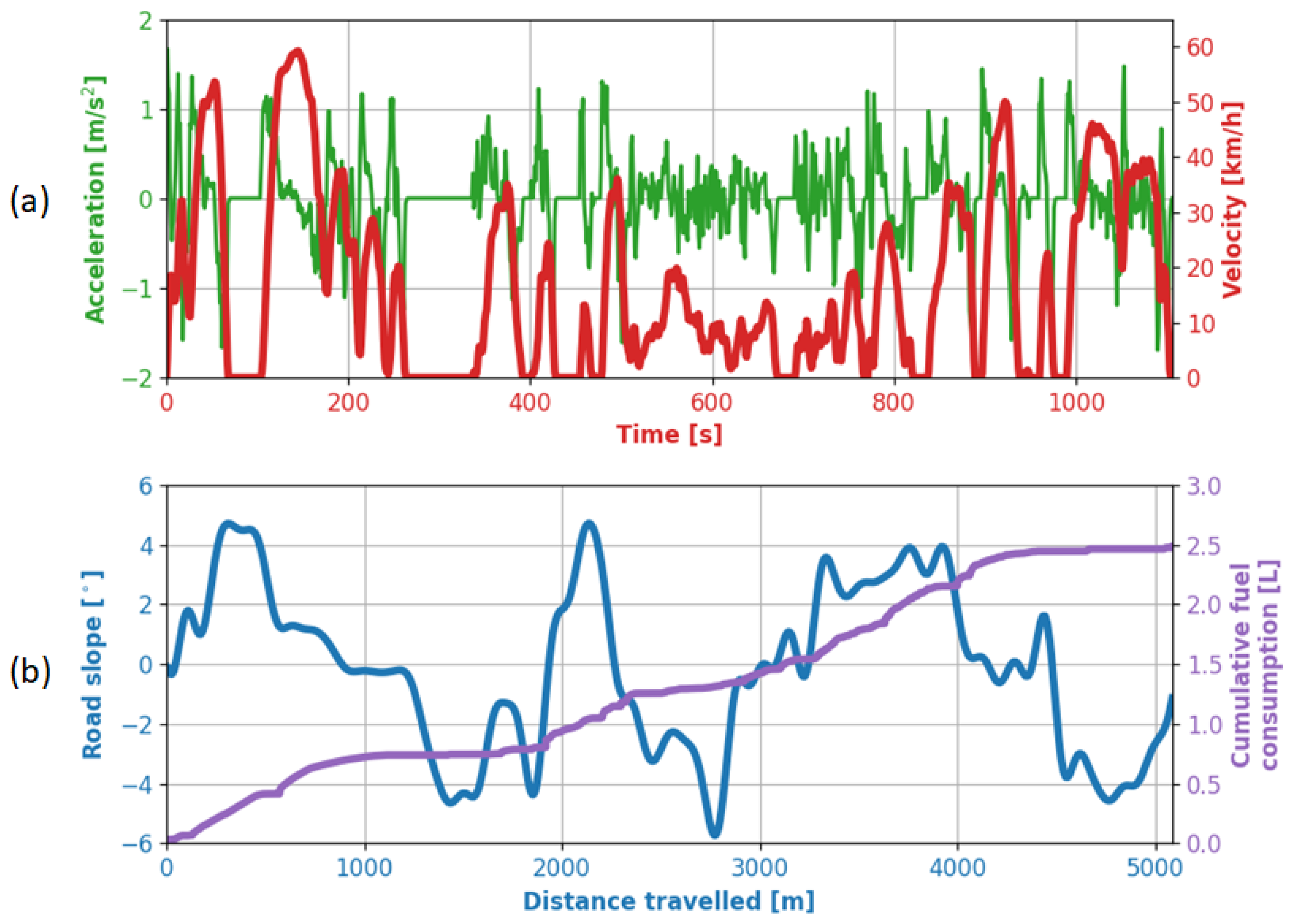
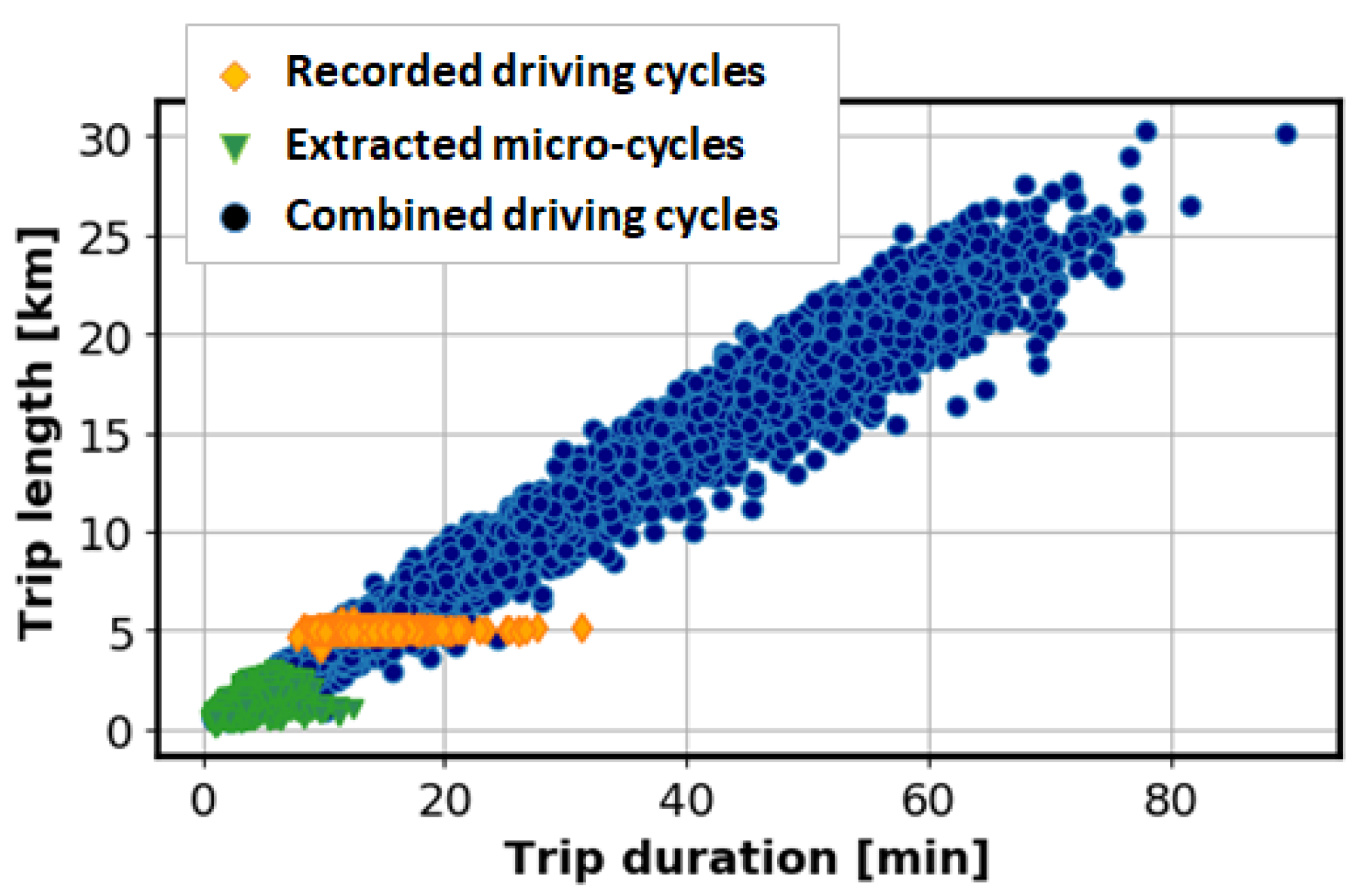


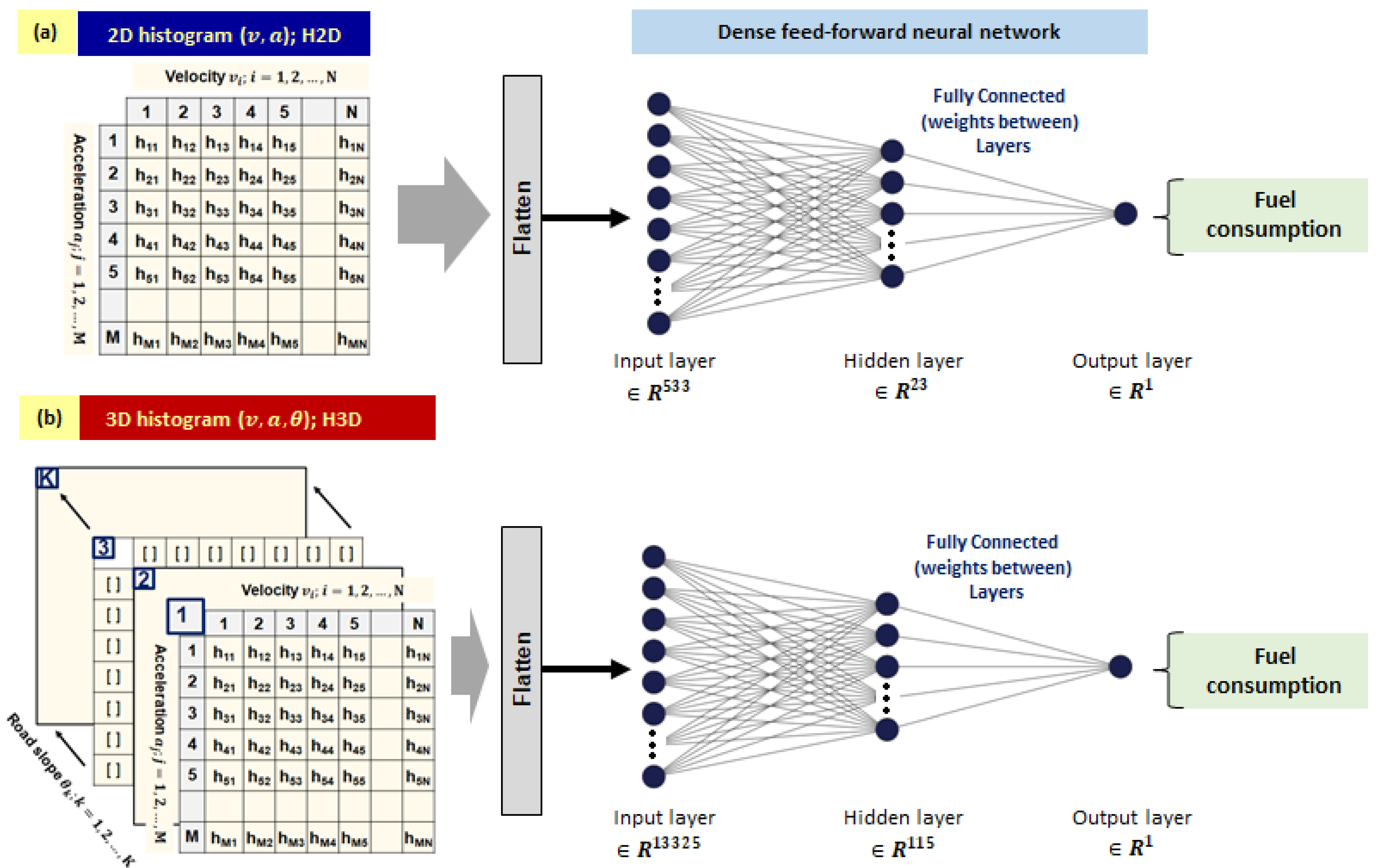
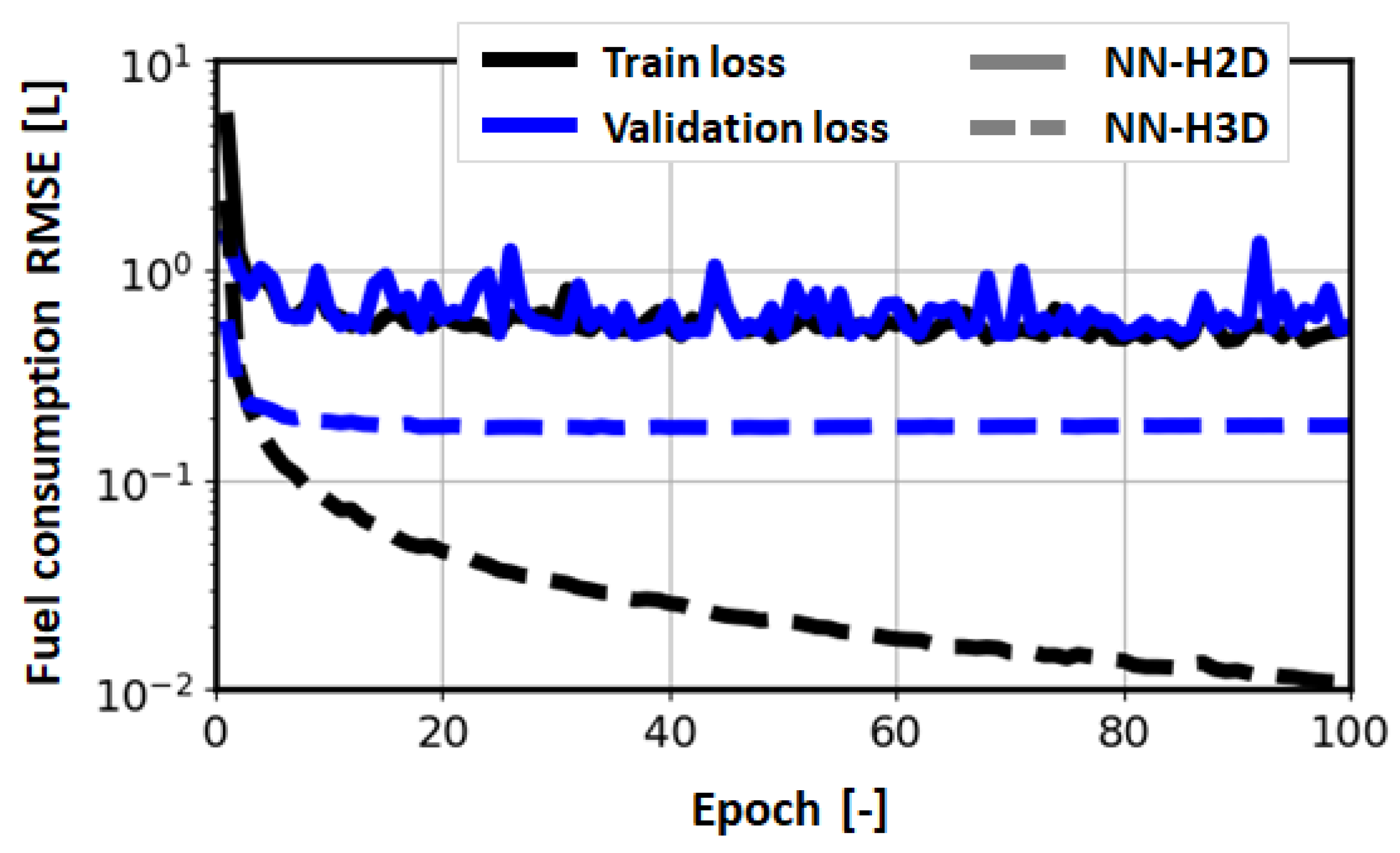
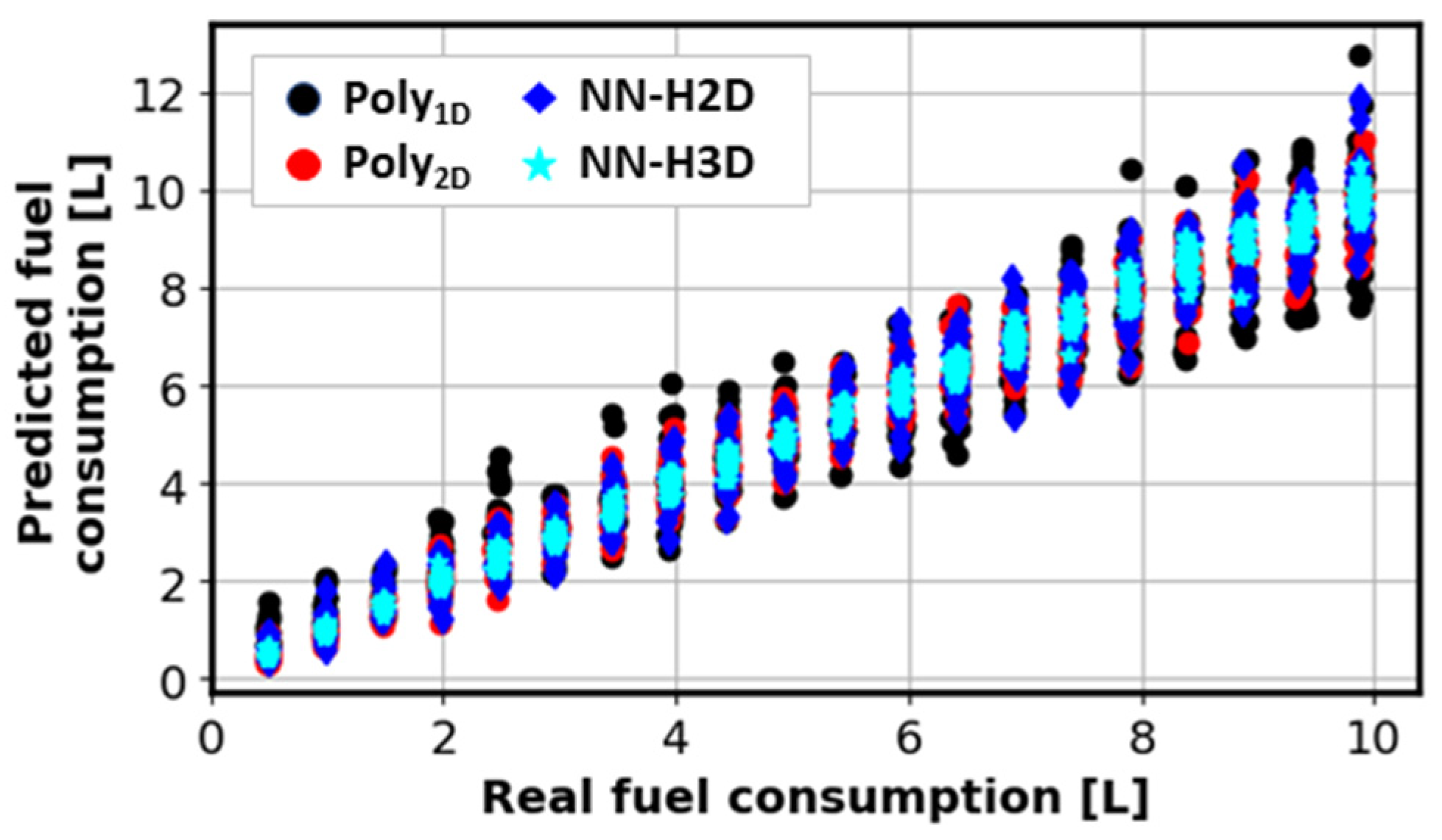

| Model | ||||
|---|---|---|---|---|
| Poly1D | 0.757 (0.697) 1 | 0.931 (0.943) | 0.0 (0.0) | 1.47 |
| Poly2D | 0.472 (0.398) | 0.973 (0.981) | 0.611 (0.674) | 3.75 |
| NN-H2D | 0.484 (0.470) | 0.972 (0.973) | 0.593 (0.534) | 920 |
| NN-H3D | 0.194 (0.133) | 0.995 (0.998) | 0.934 (0.964) | 1420 |
Publisher’s Note: MDPI stays neutral with regard to jurisdictional claims in published maps and institutional affiliations. |
© 2022 by the authors. Licensee MDPI, Basel, Switzerland. This article is an open access article distributed under the terms and conditions of the Creative Commons Attribution (CC BY) license (https://creativecommons.org/licenses/by/4.0/).
Share and Cite
Topić, J.; Škugor, B.; Deur, J. Neural Network-Based Prediction of Vehicle Fuel Consumption Based on Driving Cycle Data. Sustainability 2022, 14, 744. https://doi.org/10.3390/su14020744
Topić J, Škugor B, Deur J. Neural Network-Based Prediction of Vehicle Fuel Consumption Based on Driving Cycle Data. Sustainability. 2022; 14(2):744. https://doi.org/10.3390/su14020744
Chicago/Turabian StyleTopić, Jakov, Branimir Škugor, and Joško Deur. 2022. "Neural Network-Based Prediction of Vehicle Fuel Consumption Based on Driving Cycle Data" Sustainability 14, no. 2: 744. https://doi.org/10.3390/su14020744
APA StyleTopić, J., Škugor, B., & Deur, J. (2022). Neural Network-Based Prediction of Vehicle Fuel Consumption Based on Driving Cycle Data. Sustainability, 14(2), 744. https://doi.org/10.3390/su14020744






